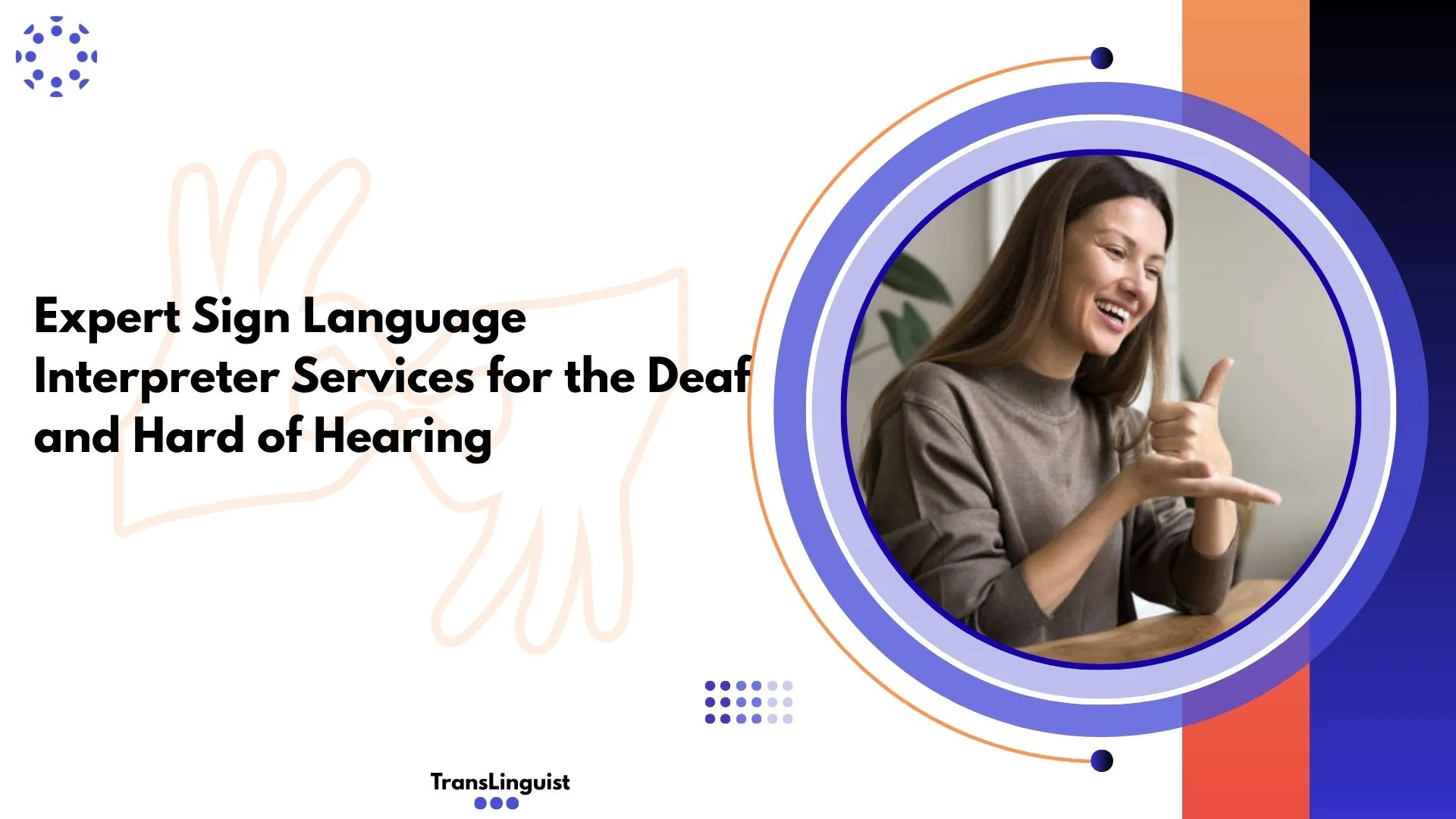If you work with Deaf or hard-of-hearing audiences, sign language interpreter services are not an optional add-on. They make information usable, meetings equitable, and decisions defensible. In the first minutes of any event or appointment, sign language interpreter services set the tone for trust. And when your team blends human expertise with the right tools, sign language interpreter services become an engine for inclusion rather than a last-minute scramble. At TransLinguist, that means certified interpreters for ASL, BSL, and International Sign, plus live captions, remote access, and speech technology that fit existing workflows.
Understanding the needs of Deaf and hard-of-hearing audiences
Language access is not one size fits all
Some participants prefer ASL or BSL as their primary language, others rely on captions in the spoken language, and many use both depending on context. Planning begins with asking what will help people participate fully, then matching the format to the moment.
Context changes the coverage you choose
A large keynote, a medical consult, and a legal intake do not carry the same risk or emotional load. Interpreters for high-stakes settings need sector fluency and clear escalation paths for sensitive content, while captions and real-time notes can support lectures or training where replay and study matter. TransLinguist staffs by specialty and event type so the right skill set meets the room.
What best-in-class service looks like
On-site, remote, and hybrid options
On-site coverage helps with complex disclosures and fast turn-taking. Remote interpreting adds speed and reach when speakers join from multiple locations. Hybrid setups require careful audio planning so that in-person and online participants share the same experience. TransLinguist supports all three modes and rehearses flows in advance to keep timing tight.
Qualified interpreters you can trust
Credentials, background checks, and ongoing feedback keep quality high. For recurring programs, dedicated teams learn your terminology and brand voice, which shortens prep and raises consistency across sessions. TransLinguist’s onboarding process is built to vet skills before anyone joins your event.
Technology that amplifies, not replaces, human expertise
Live captions and subtitles that keep pace
Accurate, readable text helps Deaf and hard-of-hearing audiences, non native speakers, and people in sound-off environments. TransLinguist’s live captions integrate with common platforms and support multilingual overlays for larger events, then deliver clean subtitles for on-demand viewing.
Speech AI that supports interpreters and audiences
Real-time speech translation and transcript generation can reduce repeats, surface terms, and create searchable notes after the session. TransLinguist’s Speech AI and VoiceSync are designed for low latency and can run alongside human interpreting without stepping on it. Use automation for speed, keep meaning with professionals.
A single control surface for busy moderators
Event teams should not juggle five applications. With TransLinguist Interactive, hosts manage language channels, caption streams, interpreter chat, and file sharing from one place, so production stays calm even as audiences scale.
Proving quality and meeting obligations
Human in the loop quality assurance
Every deliverable benefits from editorial review. Interpreters receive prep materials and glossaries, caption feeds are monitored for names and domain terms, and post-event files pass a final check before archiving. TransLinguist maintains terminology and style so repeated events sound consistent end-to-end.
Security, privacy, and records
In healthcare, legal, and public sector work, access controls and audit trails matter. Plan for authenticated logins, encrypted transport, and retention policies that match your obligations. TransLinguist’s remote and hybrid solutions are engineered for secure sessions and documented handoffs.
Answering common buyer questions inside your content
Readers often ask how accurate captions are and when to choose interpreting over text. For medical documents or patient education, a qualified interpreter carries nuance, while captions provide helpful reinforcement and searchable notes. For training and webinars, captions may suffice, but interviews, depositions, and consent conversations require interpreters present from the first minute.
Rolling out sign language access in the US
Start with the journeys that break without access
Map five scenarios where clarity matters most: town halls, board meetings, patient consults, court-adjacent conversations, and safety briefings. For each, pick the mix of ASL or BSL, captions, and transcripts, and assign an owner who can book resources quickly.
Build a lightweight playbook your teams can run
Include request deadlines, platform settings, slide and video guidance for readability, glossary updates, and contact details for interpreter pre-briefs. Add a short checklist for hosts: mic discipline, pace, lighting, and space for the interpreter window.
Measure what improves outcomes
Track attendance, completion, channel selection, questions asked, and post-event satisfaction. If sign language interpreter services and captions reduce follow-up tickets or increase participation, keep that coverage by default and expand to similar moments.
Conclusion
The fastest way to make people feel welcome is to make understanding effortless. With a mix of certified professionals and considerate technology, sign language interpreter services turn passive viewers into active participants, whether they are joining a deposition, a campus lecture, or a nationwide webcast. TransLinguist delivers on that promise with on-site, remote, and hybrid interpreting, live captions and subtitles, and low-latency speech tools that fit inside the platforms you already use. If you need sign language interpreter services that are ready for American audiences and American compliance realities, we are here to help. Start Your US Translation Project Today and give every participant a clear path to contribute.
FAQs
Do I need both interpreters and captions for every event
Not always. Use interpreters for high-stakes or interactive moments and add captions for lectures, webinars, and replays. Many organizers offer both, so participants can choose what works best.
How far in advance should I book sign language interpreter services
For large events or technical subjects, two weeks gives time to brief interpreters and test audio. Smaller meetings can be scheduled faster, but early requests secure the right specialists.
Which sign language should I request for US audiences
American Sign Language is the default for most US events. If your audience includes international participants, you may also consider International Sign or regional varieties based on attendee profiles.
Can remote interpreting deliver the same quality as on-site
Yes, with the right setup. Stable audio, clear camera framing, and a rehearsal with interpreters make remote sessions highly effective for many formats.



